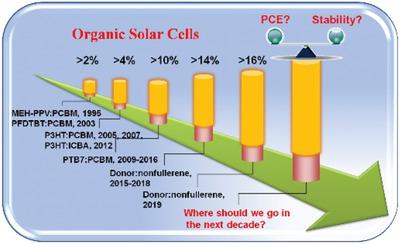当前位置:
X-MOL 学术
›
Macromol. Rapid Commun.
›
论文详情
Our official English website, www.x-mol.net, welcomes your
feedback! (Note: you will need to create a separate account there.)
Challenges to the Stability of Active Layer Materials in Organic Solar Cells.
Macromolecular Rapid Communications ( IF 4.2 ) Pub Date : 2020-01-01 , DOI: 10.1002/marc.201900437 Kun Wang 1 , Yaowen Li 2 , Yongfang Li 2
Macromolecular Rapid Communications ( IF 4.2 ) Pub Date : 2020-01-01 , DOI: 10.1002/marc.201900437 Kun Wang 1 , Yaowen Li 2 , Yongfang Li 2
Affiliation

|
In the past 20 years, organic solar cells (OSCs) have made great progress in pursuing high power-conversion efficiencies, reaching the application threshold. Instead, device stability is becoming particularly important toward commercialization. There are many factors influencing the stability of OSCs, such as light, heat, humidity, oxygen, as well as device structure. Active layer materials, as the most critical functional layer in the devices, are greatly affected by these factors in terms of both efficiency and stability. Herein, it is desirable and urgent to summarize methods for obtaining active layer materials with long-term stability, mainly focusing on the chemical structure and blending morphology. Meanwhile, the corresponding degraded mechanism of OSCs is concluded and analyzed. In this outlook, challenges for developing high-performance and stable OSCs are discussed.
中文翻译:

挑战有机太阳能电池中活性层材料的稳定性。
在过去的20年中,有机太阳能电池(OSC)在追求高功率转换效率方面取得了长足的进步,达到了应用阈值。相反,设备稳定性对于商业化变得尤为重要。有许多因素会影响OSC的稳定性,例如光,热,湿度,氧气以及器件结构。有源层材料作为设备中最关键的功能层,在效率和稳定性方面都受到这些因素的极大影响。在此,期望并且紧迫地总结用于获得具有长期稳定性的活性层材料的方法,主要集中在化学结构和共混形态上。同时,总结并分析了OSCs的相应降级机理。在这种情况下,
更新日期:2020-01-02
中文翻译:

挑战有机太阳能电池中活性层材料的稳定性。
在过去的20年中,有机太阳能电池(OSC)在追求高功率转换效率方面取得了长足的进步,达到了应用阈值。相反,设备稳定性对于商业化变得尤为重要。有许多因素会影响OSC的稳定性,例如光,热,湿度,氧气以及器件结构。有源层材料作为设备中最关键的功能层,在效率和稳定性方面都受到这些因素的极大影响。在此,期望并且紧迫地总结用于获得具有长期稳定性的活性层材料的方法,主要集中在化学结构和共混形态上。同时,总结并分析了OSCs的相应降级机理。在这种情况下,











































 京公网安备 11010802027423号
京公网安备 11010802027423号